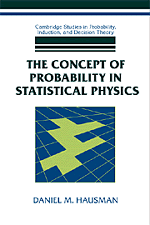Book contents
- Frontmatter
- Contents
- Introduction
- Chapter 1 The Neo-Laplacian Approach to Statistical Mechanics
- Chapter 2 Subjectivism and the Ergodic Approach
- Chapter 3 The Haar Measure
- Chapter 4 Measure and Topology in Statistical Mechanics
- Chapter 5 Three Solutions
- Appendix I Mathematical Preliminaries
- Appendix II On the Foundations of Probability
- Appendix III Probability in Nonequilibrium Statistical Mechanics
- Author Index
- Subject Index
Chapter 1 - The Neo-Laplacian Approach to Statistical Mechanics
Published online by Cambridge University Press: 12 November 2009
- Frontmatter
- Contents
- Introduction
- Chapter 1 The Neo-Laplacian Approach to Statistical Mechanics
- Chapter 2 Subjectivism and the Ergodic Approach
- Chapter 3 The Haar Measure
- Chapter 4 Measure and Topology in Statistical Mechanics
- Chapter 5 Three Solutions
- Appendix I Mathematical Preliminaries
- Appendix II On the Foundations of Probability
- Appendix III Probability in Nonequilibrium Statistical Mechanics
- Author Index
- Subject Index
Summary
THE INTRODUCTION OF STATISTICS INTO PHYSICS
In 1859, J. C. Maxwell presented his “Illustrations of the Theory of Gases” to the British Society for the Advancement of Science. In the paper he applied the theory of errors to the problem of finding “the average number of particles whose velocities lie between given limits, after a great number of collisions among a great number of particles.” The conclusion that Maxwell reached was that “the velocities are distributed among the particles according to the same law as the errors are distributed in the theory of the method of least squares.” In the second part of the paper, Maxwell distinguishes between the motion of translation of the system as a whole and the motion of agitation. The latter is characterized as a state where “the collisions are so frequent that the law of distribution of molecular velocities, if disturbed in any way, will be reestablished in an appreciably short time.” This last statement may serve to explain why “Illustrations” is considered to be the beginning of modern statistical mechanics.
The discussions on the theory of errors itself started more than 100 years earlier. Simpson discussed the idea of averaging the results of various observations in 1757. Bernoulli introduced the assumption that large errors should be regarded as less probable than small errors in 1777, and Lagrange introduced the least-squares method in an undated manuscript written in the 1770s. Other important contributors to the early stages of the theory of errors are Gauss and Legendre, but it was Laplace who systematized the theory and showed how to apply it in various contexts.
- Type
- Chapter
- Information
- The Concept of Probability in Statistical Physics , pp. 10 - 63Publisher: Cambridge University PressPrint publication year: 1999



